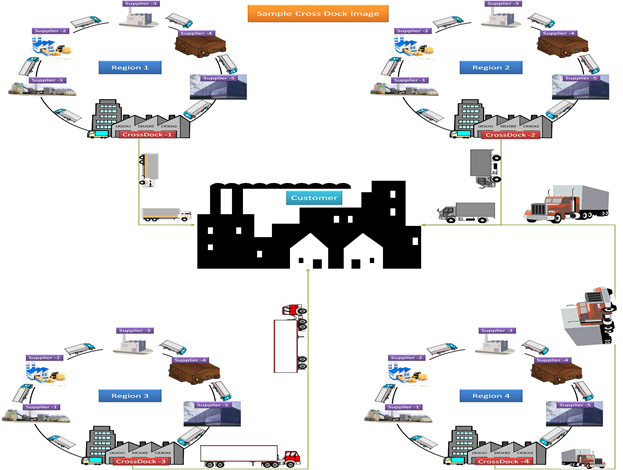Cross Dock Operations
Cross-dock operations are one of the most crucial concepts in supply chain management, which reduces the overall cost of the Supply Chain while increasing the efficiency of the supply chain. A cross dock is typically useful in a scenario where a large quantity of material has to be shipped on a regular basis to a customer / manufacture from multiple suppliers.
What is a Cross Dock?
A Cross-dock is a regional warehouse that caters to suppliers from a particular region. The supplier instead of sending the material directly to the customer, sends it to the cross dock, which in turn consolidates all items for the customer from multiple suppliers and dispatches the material on a periodic basis. Milk run concept is the basis for cross-dock operations. Typically, cross-docks store material on a temporary basis and move out the stock as soon as possible.
Types of Cross-Dock
Different types of cross -dock can be established based on operational requirements, they are:
- Manufacturer Cross Dock : This is a dedicated Cross Dock and is operated by / on behalf of a Manufacturer. Material from different suppliers is consolidated to reach optimum truckload and shipped to the manufacturer.
- Distributor Cross Dock : A distributor cross dock is a FG cross dock where material from multiple suppliers are consolidated and shipped to a customer
- ) Transport / Logistic Cross Docking: In This type of cross-dock, cargo of different carrier / logistic provider is consolidated in one truck and shipped. This is to ensure each shipment meets optimal truckload.
Let us discuss in detail of cross-docks in general and manufacturer cross-dock in particular works
How does a Cross Dock Work?
Consider a scenario where a customer / manufacturer has a facility in Bangalore. The said customer has a large number of suppliers from say:
- Delhi and Haryana in the north,
- Kolkata in the east,
- Gujarat and Maharashtra from the west and
- Chennai and Bangalore from the south of India.
The following methodologies can be used for dispatching material:
- Direct Dispatch

- Cross dock

In direct receiving, all suppliers irrespective of their location and distance from the customer will have to ship the materials individually. Suppliers who supply in large volumes will not be affected much by direct shipping, although they will have to take care of logistics. Suppliers who do not have volumes will find direct shipment to be a very costly affair.
From the customers perspective logistics / material tracking will be a nightmare. The customer will have absolutely no idea about the status of shipment, what material has been shipped in what quantity and ETA. In addition, tracking multiple suppliers, having each supplier ship material directly will add a lot of overhead on the customer in terms of Cost and Labour. In addition, shortage, excess and incorrect document verification becomes a tedious job affecting the overall efficiency of the organization.
Cross Dock Receiving
In the case of a cross dock, all suppliers associated with a cross dock will send material at a predefined time. A typical cross-dock operation is as described in the image:

Cross-Dock operation starts from the point of dispatching a truck to collect material from the suppliers. Number of trucks can vary based on the number of suppliers associated with the cross-dock as well as the quantity to be collected. The truck leaves at predefined intervals, goes to each supplier and picks up the material. Suppliers can also directly send their material to the cross-dock.
At the cross-dock, the material is unloaded, received and binned. Based on predefined schedules, the material is loaded onto a truck with higher capacity and dispatched to the customer.
The customer has to track only a finite set of trucks. The customer will also know of any shortages and excess shipments and can correct the same at the cross dock itself, reducing the load and inaccuracies at the time of GRN.
Advantages of Cross-Dock Operations
Cross-Dock operations have many advantages with a large number of suppliers concentrated in a particular area. Some of the main advantages are:
- Reduced logistic management which translates into decrease in the cost of the overall supply chain
- Shortages, Excesses and Damages can be identified and rectified at the cross-dock itself reducing reverse logistics effort and avoiding inventory shortages
- Finite number of trucks to be tracked by the customer
- Clear idea of the transit stock and ETA at the customers facility
Conclusion:
Cross-Dock implementation is useful in a scenario where multiple suppliers are concentrated in an area. Suppliers near to the customer’s facility, suppliers spread across various regions and for customers having only small amount of suppliers direct shipment would be a better idea.
Decision on cross-dock implementation should be based on tangible returns in turns of:
- Efficiency
- Supply Chain Cost
- Cost of Operating Cross-Dock and
- ROI
Cross-Dock Implementation in PALMS
PALMS provide built-in support to cross-dock operations. Some of the features available in PALMS are:
- Multiple Cross-Dock configuration
- Supplier – Part – Cross-Dock – Customer Mapping
- Route configuration with built-in support for multi cross-dock routing
- Three point validation of material and exception handling based on:
Purchase Order vs Invoiced Quantity vs Material Received - Multiple invoices against a single Purchase Order
- Dashboard and Notifications
